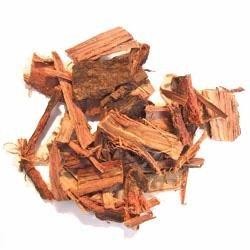Mimosa tenuiflora
Mimosa tenuiflora, commonly known as Jurema, Jurema Preta, or Tepezcohuite, is a perennial tree or shrub native to the northeastern region of Brazil and found in other parts of Central America and Mexico. It is a member of the Fabaceae family, which is known for its nitrogen-fixing properties and includes other species such as Acacia and Albizia.
Description[edit | edit source]
Mimosa tenuiflora is characterized by its fern-like leaves and thorny branches. The plant can grow up to 8 meters in height and is known for its rapid growth and resilience in arid conditions. The bark is dark brown to gray and has a fibrous texture. The flowers are small, white, and fragrant, forming in dense clusters.
Chemical Composition[edit | edit source]
The bark of Mimosa tenuiflora is rich in tannins and contains several alkaloids, most notably N,N-Dimethyltryptamine (DMT), which is a potent psychedelic compound. The presence of DMT has made the plant significant in traditional medicine and spiritual practices among indigenous peoples.
Traditional Uses[edit | edit source]
In traditional medicine, Mimosa tenuiflora has been used for its wound-healing properties. The bark is often ground into a powder and applied to the skin to treat burns, cuts, and other skin conditions. It is also used in the preparation of a traditional psychoactive brew known as Ayahuasca, although it is more commonly associated with the use of Banisteriopsis caapi.
Pharmacological Properties[edit | edit source]
Research has shown that Mimosa tenuiflora possesses antimicrobial, anti-inflammatory, and analgesic properties. The tannins in the bark contribute to its astringent effects, which can help in wound healing by promoting tissue contraction and reducing bleeding.
Cultivation and Ecology[edit | edit source]
Mimosa tenuiflora thrives in well-drained soils and can tolerate poor soil conditions due to its ability to fix nitrogen. It is often used in reforestation projects and as a natural barrier due to its dense growth and thorny branches. The plant is also important for preventing soil erosion in its native habitats.
Legal Status[edit | edit source]
The legal status of Mimosa tenuiflora varies by country, primarily due to its DMT content. In some regions, the plant is regulated under laws pertaining to psychoactive substances, while in others, it is freely cultivated and used for its medicinal properties.
Also see[edit | edit source]
Search WikiMD
Ad.Tired of being Overweight? Try W8MD's physician weight loss program.
Semaglutide (Ozempic / Wegovy and Tirzepatide (Mounjaro / Zepbound) available.
Advertise on WikiMD
|
WikiMD's Wellness Encyclopedia |
| Let Food Be Thy Medicine Medicine Thy Food - Hippocrates |
Translate this page: - East Asian
中文,
日本,
한국어,
South Asian
हिन्दी,
தமிழ்,
తెలుగు,
Urdu,
ಕನ್ನಡ,
Southeast Asian
Indonesian,
Vietnamese,
Thai,
မြန်မာဘာသာ,
বাংলা
European
español,
Deutsch,
français,
Greek,
português do Brasil,
polski,
română,
русский,
Nederlands,
norsk,
svenska,
suomi,
Italian
Middle Eastern & African
عربى,
Turkish,
Persian,
Hebrew,
Afrikaans,
isiZulu,
Kiswahili,
Other
Bulgarian,
Hungarian,
Czech,
Swedish,
മലയാളം,
मराठी,
ਪੰਜਾਬੀ,
ગુજરાતી,
Portuguese,
Ukrainian
Medical Disclaimer: WikiMD is not a substitute for professional medical advice. The information on WikiMD is provided as an information resource only, may be incorrect, outdated or misleading, and is not to be used or relied on for any diagnostic or treatment purposes. Please consult your health care provider before making any healthcare decisions or for guidance about a specific medical condition. WikiMD expressly disclaims responsibility, and shall have no liability, for any damages, loss, injury, or liability whatsoever suffered as a result of your reliance on the information contained in this site. By visiting this site you agree to the foregoing terms and conditions, which may from time to time be changed or supplemented by WikiMD. If you do not agree to the foregoing terms and conditions, you should not enter or use this site. See full disclaimer.
Credits:Most images are courtesy of Wikimedia commons, and templates, categories Wikipedia, licensed under CC BY SA or similar.
Contributors: Prab R. Tumpati, MD




